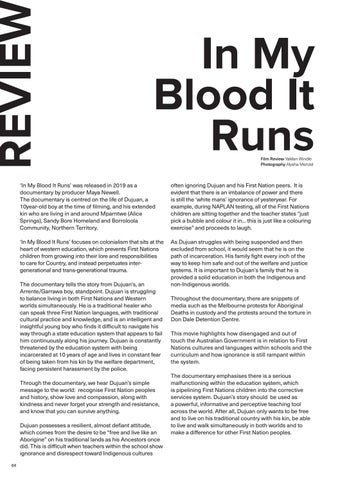In My Blood It Runs Film Review Yaliilan Windle Photography Alysha Menzel
‘In My Blood It Runs’ was released in 2019 as a documentary by producer Maya Newell. The documentary is centred on the life of Dujuan, a 10year-old boy at the time of filming, and his extended kin who are living in and around Mparntwe (Alice Springs), Sandy Bore Homeland and Borroloola Community, Northern Territory.
often ignoring Dujuan and his First Nation peers. It is evident that there is an imbalance of power and there is still the ‘white mans’ ignorance of yesteryear. For example, during NAPLAN testing, all of the First Nations children are sitting together and the teacher states “just pick a bubble and colour it in... this is just like a colouring exercise” and proceeds to laugh.
‘In My Blood It Runs’ focuses on colonialism that sits at the heart of western education, which prevents First Nations children from growing into their lore and responsibilities to care for Country, and instead perpetuates intergenerational and trans-generational trauma.
As Dujuan struggles with being suspended and then excluded from school, it would seem that he is on the path of incarceration. His family fight every inch of the way to keep him safe and out of the welfare and justice systems. It is important to Dujuan’s family that he is provided a solid education in both the Indigenous and non-Indigenous worlds.
The documentary tells the story from Dujuan’s, an Arrente/Garrawa boy, standpoint. Dujuan is struggling to balance living in both First Nations and Western worlds simultaneously. He is a traditional healer who can speak three First Nation languages, with traditional cultural practice and knowledge, and is an intelligent and insightful young boy who finds it difficult to navigate his way through a state education system that appears to fail him continuously along his journey. Dujuan is constantly threatened by the education system with being incarcerated at 10 years of age and lives in constant fear of being taken from his kin by the welfare department, facing persistent harassment by the police. Through the documentary, we hear Dujuan’s simple message to the world: recognise First Nation peoples and history, show love and compassion, along with kindness and never forget your strength and resistance, and know that you can survive anything. Dujuan possesses a resilient, almost defiant attitude, which comes from the desire to be “free and live like an Aborigine” on his traditional lands as his Ancestors once did. This is difficult when teachers within the school show ignorance and disrespect toward Indigenous cultures 64
Throughout the documentary, there are snippets of media such as the Melbourne protests for Aboriginal Deaths in custody and the protests around the torture in Don Dale Detention Centre. This movie highlights how disengaged and out of touch the Australian Government is in relation to First Nations cultures and languages within schools and the curriculum and how ignorance is still rampant within the system. The documentary emphasises there is a serious malfunctioning within the education system, which is pipelining First Nations children into the corrective services system. Dujuan’s story should be used as a powerful, informative and perceptive teaching tool across the world. After all, Dujuan only wants to be free and to live on his traditional country with his kin, be able to live and walk simultaneously in both worlds and to make a difference for other First Nation peoples.




















